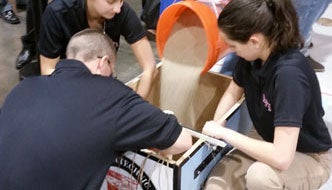A team of Rensselaer engineering students won first place in the Geo-Structures Student Challenge held during the 2016 American Society of Civil Engineers (ASCE) Geotechnical and Structural Engineering Congress. This is the second time in five years that a Rensselaer team has come home as national champions.

Tarek Abdoun
The Rensselaer students beat a field of 24 teams representing University of Illinois-Urbana-Champaign, UC Berkeley, UCLA, University of Texas-Austin, and more to win the competition, held recently in Phoenix.
According to the ASCE, the competition “provides an excellent opportunity to demonstrate that geotechnical and structural engineers must work and communicate together effectively to be successful.” The Rensselaer team’s success is a proof point for the value of The New Polytechnic: a new paradigm for teaching, learning, and research, addressing complex global challenges, the need for interdisciplinarity and collaboration, and the use of the latest tools and technologies, many of which are developed at Rensselaer.
By participating in such a challenging competition, students experience the actual design and build process of soil-structure systems much better than they would during typical classroom lectures. It’s an engaging opportunity for our students to apply their engineering knowledge and experience, while competing with their peers from other top engineering schools.”—Tarek Abdoun
Led by team adviser Tarek Abdoun, the Thomas Iovino Chaired Professor in Civil and Environmental Engineering, the team included team captain Meryl Cherchia, graduate student in civil engineering; Megan Remsen, senior in civil engineering; Brad Huizinga, senior in civil engineering; Joseph Vantassel, senior in civil engineering; and Georgios Mallios, graduate student in civil engineering.
 “By participating in such a challenging competition, students experience the actual design and build process of soil-structure systems much better than they would during typical classroom lectures,” said Abdoun. “It’s an engaging opportunity for our students to apply their engineering knowledge and experience, while competing with their peers from other top engineering schools. While RPI students usually do well in these types of competitions, winning the championship title this year is a well-deserved recognition of the team’s excellent engineering skills and very hard work.”
“By participating in such a challenging competition, students experience the actual design and build process of soil-structure systems much better than they would during typical classroom lectures,” said Abdoun. “It’s an engaging opportunity for our students to apply their engineering knowledge and experience, while competing with their peers from other top engineering schools. While RPI students usually do well in these types of competitions, winning the championship title this year is a well-deserved recognition of the team’s excellent engineering skills and very hard work.”
According to Cherchia, teams must design and build a mechanically stabilized earth (MSE) wall, a type of support used around the world for bridge abutments, to resist a given set of loading conditions with minimal deformation. The wall is reinforced by paper strips—with widths, lengths, and locations determined by each team. The goal is to use the least amount of reinforcement mass. The Rensselaer team submission’s mass was 5.6 grams. The competition also required each team to design and fabricate a frame made entirely of hardwood that could withstand the loading conditions, and again have the least amount of mass possible. The Rensselaer team’s frame had a mass of 1,440 grams. In the end, the MSE wall must stand for one minute with no load, and another minute with 30 pounds placed on the frame.
“Our team started preparing for the competition in September, submitted a design report in November, and continued practicing and optimizing our designs right up to the competition,” said Cherchia. “The dedication everyone had to this project was remarkable. There were definitely some stressful times and late nights while preparing for the competition, so for us to ultimately take first place means a great deal to us. It was amazing to see all of our hard work pay off!
“From a student perspective, this type of competition is extremely rewarding. It gives us the opportunity to experience, hands-on, the theories that we’ve studied in our coursework,” Cherchia said.


